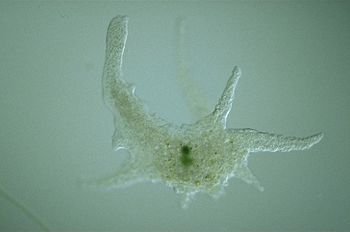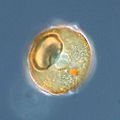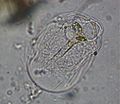Amoebozoa facts for kids
Quick facts for kids AmoebozoaTemporal range: 1000–0Ma
|
|
|---|---|
 |
|
| Chaos carolinensis | |
| Scientific classification |
|
| Domain: | Eukaryota |
| (unranked): | Unikonta |
| Phylum: | Amoebozoa Lühe, 1913 emend. Cavalier-Smith, 1998 |
| Subphyla, infraphyla and classes | |
|
|
| Synonyms | |
|
|
The Amoebozoa are a group of tiny living things, mostly like amoebas. They are a type of eukaryote, which means their cells have a nucleus. Most Amoebozoa move by pushing their insides (called cytoplasm) around. This creates finger-like extensions called pseudopods, which help them crawl and grab things.
There are about 2,400 known kinds of Amoebozoa. Scientists often place them in a large group called Protista or Protozoa. Some scientists also call them a "supergroup" within the Eukaryota.
Contents
What are Amoebozoa?
Scientists use DNA studies to understand how living things are related. These studies show that Amoebozoa form a single group, meaning they all came from a common ancestor. They are closely related to another big group called Opisthokonta. This group includes fungi and animals, plus many tiny single-celled organisms.
Sometimes, Amoebozoa and Opisthokonta are put together in an even bigger group. This group has different names like Unikonta.
Where do Amoebozoa live?
Amoebozoa include many well-known amoeba-like organisms. Some examples are Chaos, Entamoeba, Pelomyxa, and the famous Amoeba itself.
Most Amoebozoa are made of only one cell. They are common in soil and in water habitats. Some live inside other organisms, sometimes causing diseases. The Amoebozoa group also includes slime moulds. These are special kinds that can be seen without a microscope. They can have many nuclei in one cell or form many cells together. Slime moulds also make spores.
How do Amoebozoa get food?
Amoebozoa usually eat by a process called phagocytosis. This is when the cell surrounds food particles. It then pulls them inside into small sacs called vacuoles. Inside these sacs, the food is digested and used by the cell.
When there isn't much food, most Amoebozoa can form cysts. These are tough, protective coverings that help them survive. Cysts can be carried by the wind to new places. In slime moulds, these protective structures are called spores. They grow on stalk-like parts called fruiting bodies or sporangia.
Movement and Features
Most Amoebozoa do not have flagella. Flagella are tiny, whip-like tails that help some cells move. Amoebozoa also usually don't have other structures supported by microtubules, except when their cells divide (called mitosis).
However, some types of Amoebozoa, called archamoebae, do have flagella. Also, many slime moulds produce gametes (special cells for reproduction) that have two flagella. A well-known example of an Amoebozoa is the Dictyostelium discoideum. Scientists often study this organism to learn more about cells.
Images for kids
-
Entamoeba histolytica trophozoite (Conosa: Archamoebae)
-
Dictyostelium discoideum (Conosa: Dictyostelia)
See also
 In Spanish: Amoebozoa para niños
In Spanish: Amoebozoa para niños










